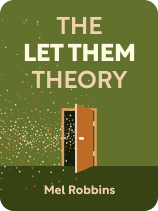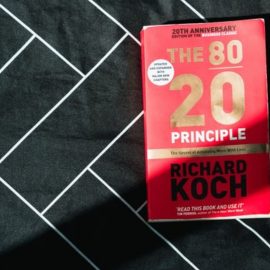

This article is an excerpt from the Shortform book guide to "The Let Them Theory" by Mel Robbins. Shortform has the world's best summaries and analyses of books you should be reading.
Like this article? Sign up for a free trial here.
Do you want to know how to take accountability in relationships? How can you adapt to ever-changing friendships over time?
Although relationships involve multiple people, it’s ultimately up to you to create the relationships you want in your life. Mel Robbins uses the Let Them Theory to show a way you can both release control and set boundaries in romantic and platonic relationships.
Get ready to build the relationships you deserve by using the simple phrases, “Let Them” and “Let Me.”
Take Responsibility in Relationships
Saying “Let Them” and “Let Me” gives you a way to take accountability in relationships. Other people’s words and actions can send us on an emotional rollercoaster: When we internalize the negative things they say and do, we often feel inferior. For example, if your colleague walks into the office one morning and immediately snaps at you, you’d likely feel you must have done something wrong that justifies their rudeness. But they might just be in a bad mood because their shoelace broke or they missed their train—circumstances that don’t involve you.
Conversely, it can make you feel superior to just think “let them” and dismiss your colleague’s behavior—thinking you’re the bigger person who’s above such pettiness or judging them for being rude. But that wouldn’t be a productive way forward, as it still involves judgment rather than true acceptance.
Robbins explains that you’re responsible for building the relationships you want with other people. In the situation with your grumpy colleague, that means that you wouldn’t respond to their rudeness in kind, but instead look at them with empathy and figure out how you can make their day better. Robbins notes that if you say “Let Them” without following it up with “Let Me,” then you can end up feeling isolated from others. It’s by saying “Let Me” that you exercise your agency to be the person you want to be—for example, the kind of coworker who speaks to your colleagues with the consideration they deserve.
| How Humans—and Whales—Navigate Stormy Seas Robbins’s advice to not just accept others’ behavior (“Let Them”) but to actively choose intentional and empathetic responses (“Let Me”) aligns with neuroscience research on specialized brain cells called spindle neurons, or von Economo neurons (VENs). These neurons seem to exist in just a handful of species: humans, great apes, elephants, and whales—all animals known for their complex social behaviors and apparent capacity for empathy. Spindle neurons are uniquely structured for rapid processing of social and emotional information, allowing quick transmission of signals across different brain regions. Scientists have found that these neurons appear in brain areas responsible for social awareness, emotional processing, and what they call “sympathetic concern.” These are precisely the neural foundations needed for the sophisticated relationship dance Robbins describes: noticing someone’s negative behavior, choosing not to take it personally, and then deciding how to respond constructively. The presence of these neurons in whales—who may have had them for 30 million years, twice as long as humans—suggests that the ability to maintain social bonds through empathetic responses might be a specialized evolutionary adaptation. While most animals react defensively or withdraw when faced with hostility, species with spindle neurons can override this instinct, potentially allowing them to consider: “How might I respond in a way that strengthens rather than damages this relationship?” When Robbins suggests responding to your colleague’s rudeness with empathy rather than defensiveness, she’s inviting you to engage these advanced neural pathways—a capacity that appears to be rare in the animal kingdom but which defines some of Earth’s most socially sophisticated species. |
The same principle applies to friendships, too: Robbins explains you have to create the community you desire by adapting to the evolution of your friendships over time. When friends move away, prioritize new connections, or have less time for you, you need to say “Let Them” instead of clinging tightly or feeling hurt. At the same time, use “Let Me” to consider what matters most in adult friendships: proximity, timing, and energy. Proximity refers to physical closeness, which creates opportunities for interaction. Timing involves being at similar life stages. Energy is the effort you put in nurturing the friendship. If these are lacking, you can take action to realign yourself with a friend who seems distant—or make new connections.
(Shortform note: Robbins’s emphasis on proximity, timing, and energy as key to staying connected as friendships evolve is backed by neuroscience. When we spend time in physical proximity to friends, our brains release oxytocin, which activates reward circuits and strengthens our bond. Timing is important, too: When friends experience similar challenges, their brain activity actually synchronizes—so we’re literally “on the same wavelength” with friends in compatible life stages. Finally, the energy we invest in friendships creates a safety net. When facing stressful situations, people with strong social connections show reduced activity in brain regions associated with threat processing—so challenges seem less threatening with support.)
Robbins notes that you can take the same approach to romantic relationships as well. When you’re dating someone, you have to “Let Them” show you who they really are, what they want in life, and whether you’re a priority to them. If they’re not the kind of person you want to be with, then you can let the relationship go to make space for someone else who can offer the love, commitment, and compatibility you deserve. No relationship is perfect, and every relationship hits rough patches. But if you agree on your values and support each other’s dreams, are willing to put in the effort to make the relationship work, and can accept each other as you are, then you can love them for who they are rather than for who you wish they could be.
(Shortform note: Robbins’s advice to let other people show you who they are echoes writer and poet Maya Angelou’s wisdom: “When someone shows you who they are, believe them the first time.” People reveal their authentic selves through consistent patterns of action, but we resist seeing them as they are because we’re invested in seeing the “potential” in romantic partners. This tendency to ignore what people are clearly showing us often stems from what psychologists call optimism bias, our tendency to overestimate the likelihood of positive outcomes despite evidence to the contrary. It’s why we overlook red flags, excuse behavior that conflicts with our values, and convince ourselves people will make an exception to established patterns.)

———End of Preview———
Like what you just read? Read the rest of the world's best book summary and analysis of Mel Robbins's "The Let Them Theory" at Shortform.
Here's what you'll find in our full The Let Them Theory summary:
- A simple but powerful framework for reclaiming your time and mental energy
- How to detach from situations and behaviors that are outside your influence
- How the "let them" theory can be taken too far, and how to avoid it from happening






